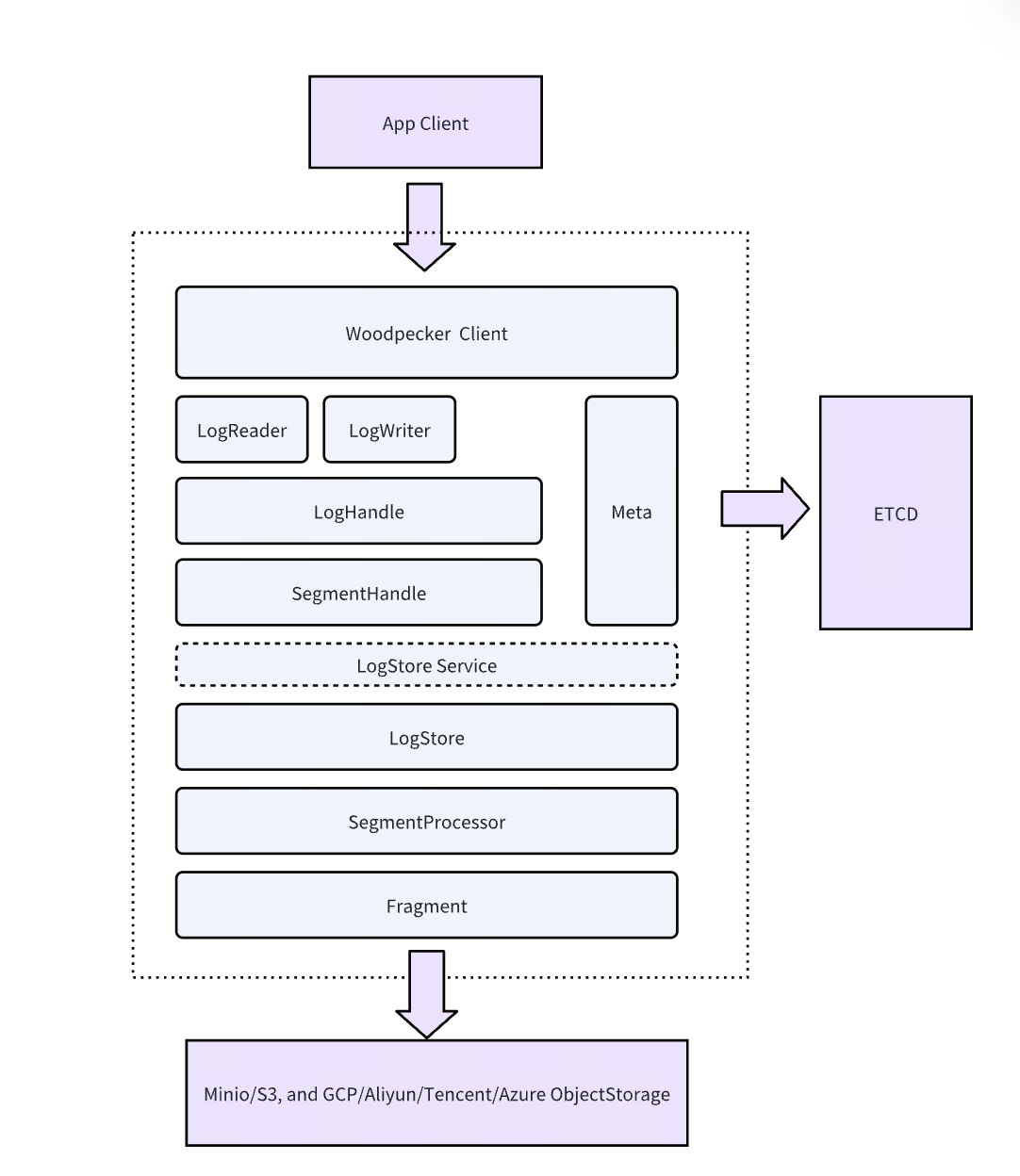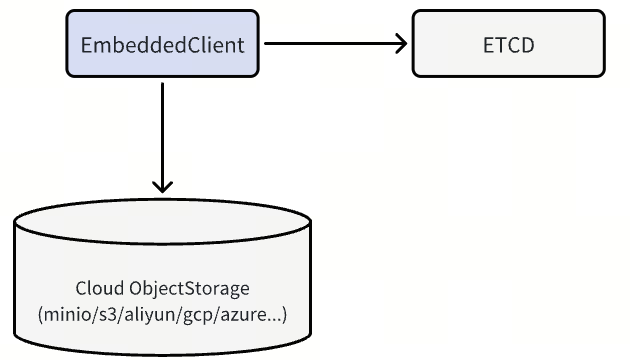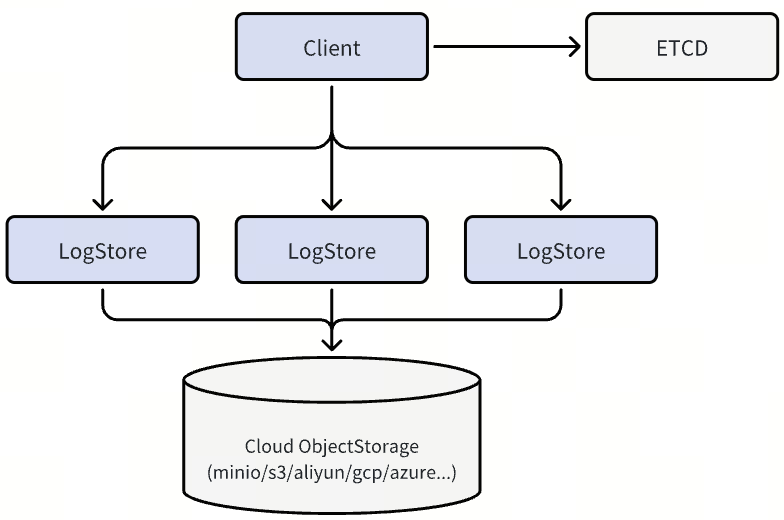Woodpecker
In Milvus 2.6, Woodpecker replaces Kafka and Pulsar with a purpose-built, cloud-native write-ahead log (WAL) system. Engineered for object storage, Woodpecker simplifies operations, maximizes throughput, and scales effortlessly.
Woodpecker’s design goals:
Highest throughput in cloud environments
Durable, append-only logging for reliable recovery
Minimal operational overhead with no local disks or external brokers
Zero-disk architecture
Woodpecker’s core innovation is its zero-disk architecture:
- All log data stored in cloud object storage (such as Amazon S3, Google Cloud Storage, or Alibaba OS)
- Metadata managed through distributed key-value stores like etcd
- No local disk dependencies for core operations
 woodpecker layers
woodpecker layers
Architecture components
A standard Woodpecker deployment includes the following components:
- Client: Interface layer for issuing read and write requests
- LogStore: Manages high-speed write buffering, asynchronous uploads to storage, and log compaction
- Storage backend: Supports scalable, low-cost storage services such as S3, GCS, and file systems like EFS
- Etcd: Stores metadata and coordinates log state across distributed nodes
Deployment modes
Woodpecker offers two deployment modes to match your specific needs:
MemoryBuffer - Lightweight and maintenance-free
MemoryBuffer mode provides a simple and lightweight deployment option where Woodpecker’s embedded client temporarily buffers incoming writes in memory and periodically flushes them to a cloud object storage service. In this mode, the memory buffer is embedded directly into the client, enabling efficient batching before flushing to S3. Metadata is managed using etcd to ensure consistency and coordination. This mode is best suited for batch-heavy workloads in smaller-scale deployments or production environments that prioritize simplicity over performance, especially when low write latency is not critical.
 woodpecker memory mode deployment
woodpecker memory mode deployment
QuorumBuffer - Optimized for low-latency, high-durability
QuorumBuffer mode is designed for latency-sensitive, high-frequency read/write workloads requiring both real-time responsiveness and strong fault tolerance. In this mode, Woodpecker’s client interacts with a three-replica quorum system to provide high-speed write buffering, ensuring strong consistency and high availability through distributed consensus.
A write is considered successful once the client successfully replicates data to at least two of the three quorum nodes, typically completing within single-digit milliseconds, after which the data is asynchronously flushed to cloud object storage for long-term durability. This architecture minimizes on-node state, eliminates the need for large local disk volumes, and avoids complex anti-entropy repairs often required in traditional quorum-based systems.
The result is a streamlined, robust WAL layer ideal for mission-critical production environments where consistency, availability, and fast recovery are essential.
 woodpecker quorum mode deployment
woodpecker quorum mode deployment
Performance benchmarks
We ran comprehensive benchmarks to evaluate Woodpecker’s performance in a single-node, single-client, single-log-stream setup. The results were impressive when compared to Kafka and Pulsar:
| System | Kafka | Pulsar | WP Minio | WP Local | WP S3 |
|---|---|---|---|---|---|
| Throughput | 129.96MB/s | 107MB/s | 71MB/s | 450MB/s | 750MB/s |
| latency | 58ms | 35ms | 184ms | 1.8ms | 166ms |
For context, we measured the theoretical throughput limits of different storage backends on our test machine:
- MinIO: ~110 MB/s
- Local file system: 600–750 MB/s
- Amazon S3 (single EC2 instance): up to 1.1 GB/s
Remarkably, Woodpecker consistently achieved 60-80% of the maximum possible throughput for each backend—an exceptional efficiency level for middleware.
Key performance insights
- Local File System Mode: Woodpecker achieved 450 MB/s—3.5× faster than Kafka and 4.2× faster than Pulsar—with ultra-low latency at just 1.8 ms, making it ideal for high-performance single-node deployments.
- Cloud Storage Mode (S3): When writing directly to S3, Woodpecker reached 750 MB/s (about 68% of S3’s theoretical limit), 5.8× higher than Kafka and 7× higher than Pulsar. While latency is higher (166 ms), this setup provides exceptional throughput for batch-oriented workloads.
- Object Storage Mode (MinIO): Even with MinIO, Woodpecker achieved 71 MB/s—around 65% of MinIO’s capacity. This performance is comparable to Kafka and Pulsar but with significantly lower resource requirements.
Woodpecker is particularly optimized for concurrent, high-volume writes where maintaining order is critical. And these results only reflect the early stages of development—ongoing optimizations in I/O merging, intelligent buffering, and prefetching are expected to push performance even closer to theoretical limits.
Operational benefits
Woodpecker’s cloud-native architecture delivers significant operational advantages:
- Zero local storage management: Eliminates disk volume management, RAID configuration, and hardware failures
- Automatic scaling: Storage scales with cloud object storage without capacity planning
- Cost efficiency: Pay-as-you-go storage with automatic tiering and compression
- High availability: Leverages cloud providers’ 11-nines durability with fast recovery
- Simplified deployment: Two deployment modes (MemoryBuffer/QuorumBuffer) match different operational needs
- Developer-friendly: Faster environment setup and consistent architecture across all environments
These advantages make Woodpecker particularly valuable for mission-critical RAG, AI agents, and low-latency search workloads where operational simplicity is as important as performance.